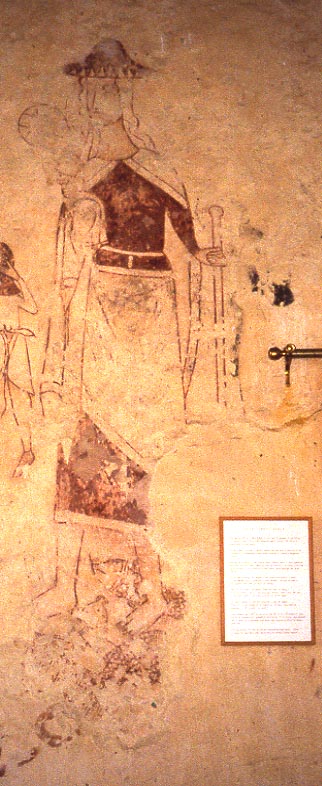Stoke Dry, Rutland (†Peterborough) C.14
St Christopher

The most remarkable thing about this comparatively early St Christopher is his manner of dress. He has a tight, long-sleeved tunic decorated with bands of white at waist and hip, and some kind of belt-clasp or brooch placed centrally between them. His tunic skirt, if that is what it is, has a broader white band around the hem. On top of this is something that looks like a white apron with a sharply diagonal hem, and over all a whitish cloak. At the left, the saint holds the Christ Child apparently wrapped in the folds of this cloak, or, perhaps, in the wrapped apron-like garment. Possibly these items of clothing are one and the same, the outer cloak so voluminous that it wraps around the right arm and the child and then around the tunic skirt as well. These oddities are also evident to some extent in the clothing of the right-hand archer in the Martyrdom of St Edmund, part of which is just visible at the far left.
The saint’s headgear is even odder – a high-crowned affair like a small sombrero, with triangular shapes decorating its brim. It is hard to tell whether or not he has a beard, but his long, rather feminine hair curls down below his shoulders. His staff, short and very plain with a rounded top like that at Fritton, is surprisingly plain by contrast with his exotic appearance otherwise. Several very scaly fish swim around his feet.
It might be, as has been suggested, that St Christopher’s clothing – his hat particularly – is simply an imaginative and idiosyncratic version of a pilgrim’s garb. Probably the simplest explanation, that this painter had a particularly individual and quizzical eye, is the true one, and it would account for the generally enigmatic air surrounding all the paintings at Stoke Dry.
These include the Martyrdom of St Edmund linked above; and the Martyrdoms of St Andrew and St Margaret.
Website for St Andrew’s church Stoke Dry
† in page heading = Diocese